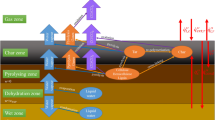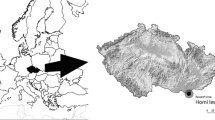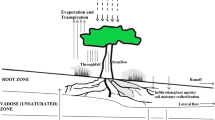Abstract
The influence of moisture content (MC) on the dynamic modulus of elasticity of structural lumber was investigated using transverse vibration testing methods. The flexural rigidity (EI) of a transversely vibrating beam was calculated as the modulus of elasticity (E) multiplied by the moment of inertia (I). The increase in E of lumber due to reduction in moisture content was computed by assuming that the flexural rigidity remains constant with changes in moisture content. Reductions in I due to shrinkage were compensated by the increases in E which led to a proposal for a species-dependent MC adjustment model for modulus of elasticity. The model was validated using 38 mm × 89 mm × 4,290 mm western Canadian Spruce–Pine–Fir dimension lumber evaluated in the “as-received” and “dry” conditions. Results obtained from the species-dependent model agreed closely with those from the E adjustment equation for dimension lumber given in ASTM D 1990. The results show that the ASTM moisture adjustment procedures can be used to adjust dynamic E values for changes in moisture content also.








Similar content being viewed by others
References
Alden H (1997) Softwoods of North America. United States Department of Agriculture, Forest Service, Forest Products Laboratory. Gen Tech Rep FPL-GTR-102
American Society for Testing and Materials (ASTM) (2006a) Standard test methods for mechanical properties of lumber and wood-base structural material. ASTM D 4761, West Conshohocken
American Society for Testing and Materials (ASTM) (2006b) Standard practice for establishing allowable properties for visually-graded dimension lumber from in-grade tests of full-size specimens. ASTM D 1990, West Conshohocken
Aplin EN, Green DW, Evans JW, Barrett JD (1986) The influence of moisture content on the flexural properties of Douglas fir dimension lumber. United States Department of Agriculture, Forest Service, Forest Products Laboratory, Res Pap FPL-475
Barrett JD, Lau W (1994) Canadian lumber properties. Canadian Wood Council, Ottawa, chap 9, pp 223–254
Green DW (1989) Moisture content and the shrinkage of lumber. United States Department of Agriculture, Forest Service, Forest Products Laboratory, Gen Res Pap FPL-RP-489
Green DW, Evans JW (2001) Evolution of standardized procedures for adjusting lumber properties for change in moisture content. United States Department of Agriculture, Forest Service, Forest Products Laboratory, Gen Tech Rep FPL-GTR-127
Green DW, Evans JW, Barrett JD, Aplin EN (1988) Predicting the effect of moisture content on the flexural properties of Douglas-fir dimension lumber. Wood Fiber Sci 20(1):107–131
Green DW, Evans JW, Pellerin R (1991) Moisture content and the flexural properties of lumber: species differences. 1991 International Timber Engineering Conference, London
Haines DW, Leban J (1997) Evaluation of the MOE of Norway spruce by the resonance flexure method. For Prod J 47(10):91–93
Madsen B (1992) Structural behaviour of timber. Timber Eng Ltd, UK
McLain TE, DeBonis AL, Green DW, Wilson FJ, Link CL (1984) The influence of moisture content on the flexural properties of southern pine dimension lumber. United States Department of Agriculture, Forest Service, Forest Products Laboratory, Res Pap FPL-447
Murphy JP (2000) Commentary on factors affecting transverse vibration using an idealized theoretical equation. United States Department of Agriculture, Forest Service, Forest Products Laboratory, Res Note FPL-RN-0276
Ross RJ, Geske EA, Larson GH, Murphy JF (1991) Transverse vibration nondestructive testing using a personal computer. United States Department of Agriculture, Forest Service, Forest Products Laboratory, Res Pap FPL-RP-502
Seeling U (1998) Natural frequency of wood—a reliable parameter for grading timber of all qualities? 11th international symposium on nondestructive testing of wood, Madison
Timoshenko SP, Young DH, Weaver W (1974) Vibration problems in engineering, 4th edn. Wiley, New York
Author information
Authors and Affiliations
Corresponding author
Rights and permissions
About this article
Cite this article
Barrett, J.D., Hong, JP. Moisture content adjustments for dynamic modulus of elasticity of wood members. Wood Sci Technol 44, 485–495 (2010). https://doi.org/10.1007/s00226-009-0292-z
Received:
Published:
Issue Date:
DOI: https://doi.org/10.1007/s00226-009-0292-z




